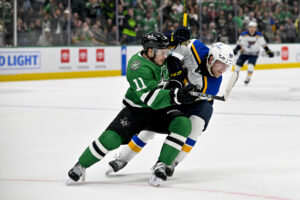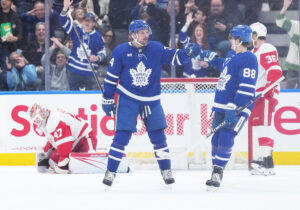“Advanced stats” has become a kind of buzz word around the hockey world. It’s emerging into the NHL as it did years ago with the MLB. Hockey teams have entire departments for analytics, and it has become a war (pun intended) of sorts between two sides: The Data Nerds vs. Old School Hockey. What I intend to do is break down some of the common stats used in analytics to help people get introduced into the world of NHL analytics.
Be sure to check the rest of the series:
Understanding NHL Advanced Stats: Part Two
All expected goal data will come from Evolving Hockey, however, there are a number of good resources out there, such as MoneyPuck or HockeyViz who both provide extremely good expected goals models.
Expected Goals
This is the big one. While corsi is one of the most common “advanced” stats you’ll hear, expected goals (xG) is arguably the most important. As discussed last time, corsi represents the quantity of attempts. It looks at how many. Expected goals looks at the quality of these attempts. This stat looks at how likely a shot attempt was at going into the net.
https://twitter.com/racheldoerrie/status/1233034412360597504
Rachel Doerrie describes it best in the Tweet above. These xG models are based on hundreds of thousands of points of data. Thanks to the observation of all the events over time we can use relative frequency to firmly know the odds of a shot attempt has at going in the net. We are sure of this because of the law of large numbers. As a procedure is repeated again and again, the relative frequency probability of an event tends to approach the actual probability.
Enough with the boring reasoning of how the stat is formed and why it is sound. It’s time to talk about application and context.
Expected Goals For, Against and Percentages
Now that we know that xG shows us how likely any given shot is to go in, we can now look to understand the numbers of it. Similar to corsi, the is expected goals for (xGF) and expected goals against (xGA). Again, expected goals can be shown as a percent (xGF%) and for an individual (ixG), like corsi. Individual expected goals is a lot more useful of a stat than individual corsi is. This is because it shows how many goals a single player was expected to score himself.
Expected goals for percentage is once again excellent at showing how good a player is overall at the game. 50% is the threshold for over a full season that should be used to measure. When a player is above 50% they are helping their team generate higher quality chances than they give up when they are on the ice. When a team is above 50% they, simply, as a whole generated higher quality chances than their opponent.
Expected Goals as Rates
Since we have the raw totals for xG we can look at them in per 60 rates (xGF/60 and xGA/60). While xGF% is fine to look at the overall picture of a team, or how effective a player is overall (at both ends of the ice), there will be times that looking at the rates of a player will be more useful.
All of the following examples will be from Evolving Hockey at 5v5 with at least 500 minutes played. We can see in the 2019-20 season that two of the worst players in terms of xGA/60 were Kyle Connor and Mark Scheifele. These two players had an xGA/60 of 3.21 and 3.18 respectively. Conversely, the best player in terms of this stat was Zach Aston-Reese with an incredible xGA/60 of 1.54. In terms of xGF/60, we see Mark Stone leading the NHL at 3.47 and Austin Watson at the bottom with 1.49.
You may ask why I just spent a paragraph listing off the stats of players in the NHL. My goal is to not just explain what the stats are and how they are calculated, but to give context to them. These stats will mean nothing if one doesn’t know what a good stat is in this context. Typically, I judge xGF/60 as the following, bad<2.00-2.5<good, and the opposite is true for xGA/60. Anything between the 2.00 to 2.5 range is standard to pretty good.
Where Next for Expected Goals?
Thanks to Ryan Stimson‘s “Passing Project”, Corey Sznajder‘s tracking, and Alex Novet‘s work at Hockey Graphs, we know that there better expected goals models exist that look at pre-shot movement. This takes into account passes and pass types that take place prior to the shot attempt. The public data does not supply this type of data, so it is difficult to create a model with just public tracking.
Next time in Understanding NHL Analytics: A Beginners Guide we will look at goalie stats. If you have any questions, feel free to reach out on Twitter.
Main photo:
Embed from Getty Images






